A Window To The Past: Burgundy’s Strongest Statement is Fully In Evidence In Ten-Year-Old Gevrey-Chambertin Seventeen 2014 Wines Show Depth And Breed. (4-Bottle Village-Pack $379) + (3-Bottle Premier Cru-Pack $379)
A Gevrey New Year from us to you! In a time of reflection and introspection, we’re also suggesting a bit of ‘retrospection’—a deep dive into the marvelously mature 2014s from the Burgundian appellation most celebrated for its longevity. This curated selection is a window into the art of evolution as it applies to Gevrey-Chambertin Pinot Noir held in ideal conditions for the past decade. From some of the finest producers in Gevrey, these are wines which emerge from their chrysalis of cellaring to display the nuanced emotion, complexity, refinement and texture that only patience can reveal.
Consider this a celebration of the moment when you truly recognize that a wine’s aroma has become its bouquet.

What Makes A Wine Great?
Superlative winemaking involves a formula that’s part science and part soul. It’s not a stretch to liken the process to a recipe, and so a comparison of a great wine and the steps required to produce a perfectly prepared, top-end Wagyu ribeye steak may be apropos. Like wine, an exceptional piece of beef must trace its origins to the earth itself: Wagyu cattle are pampered from birth, fed a high-protein diet, often massaged and given beer to encourage marbling. Likewise, the vineyards that produce top quality wines enjoy both breeding and babying; adding to the natural elements is a cycle of biodynamics to mollycoddle microbic life, with the correct attention paid to moisture, food and pruning. While in the growth stage, all possible care is taken so that the vines do not fall prey to disease or mismanagement.
And the same holds true for the steer.
Once harvested, both products are handled with extra care, but in the cellar—as in the kitchen—the skill of the creator is paramount. A misstep along the way may result in a whole lot of wasted effort earlier in the game.
Of course, for both beef and bottle, the consumer is the ultimate benefactor and the decisive judge; the time the wine spends maturing toward an ‘ideal’ state is the time the steak spends over the flame. This is, of course, an optimal and somewhat measurable period depending on individual tastes, but a given consensus can certainly be formed and debated.
And this is precisely the key factor separating great wine (and great cuisine) from the also-rans, just as it is true that the broader the consensus, the pricier the product tends to become.
The esoterica we consider when we call a wine ‘great’ are nuance and identity. The former is formed purely through organoleptic sensations, the latter via reputation and history—how well the wine represents and reflects its place of origin. The status of ‘great’ must always be opinion, but at the same time, the more you know and the deeper you look, the more credible your opinion becomes.
So, to ring in 2024, let’s raid the cellar and fire up the grill and put these theories to the ultimate test!
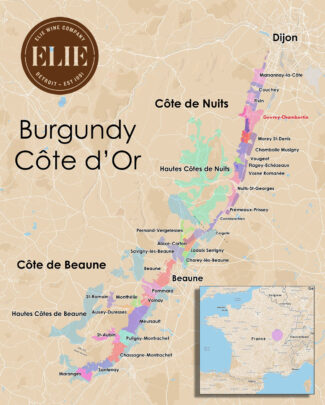
Gevrey-Chambertin: Setting The Boundaries
“The Emperor will drink only Chambertin,” said Louis Constant Wairy, Napoleon’s valet.
Indeed. So what does Gevrey-Chambertin have in common with Westland, Michigan? Not much, except that Westland was named for a mall and Gevrey-Chambertin is named for a vineyard. As those schooled in Burgundian lore know, during the nineteenth century it became fashionable for villages in the Côte d’Or to adopt double-barreled names, adding a hyphen followed by the name of their most famous vineyard: Thus Chambolle added Musigny and Gevrey added Chambertin.
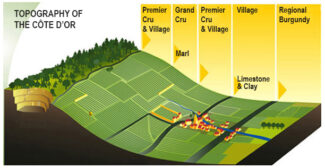
In minimalism, less may be more, and in wine—especially those with a hyphenated name—more may be less; a village-level Gevrey-Chambertin, for example, does not seek to compete with the quality of ‘Le Chambertin’ itself. But if nothing else, its name reminds you that it comes from a rarefied zip code. And to be sure, the region is hallowed grapeland, graced with the Holy Trinity of terroir—elevation, climate and soil structure. Contained within the appellation are nine Grand Crus and 26 Premier Crus (whose name on the label may be followed by the name of the climat of origin) as well as nearly a thousand acres of Villages wine.
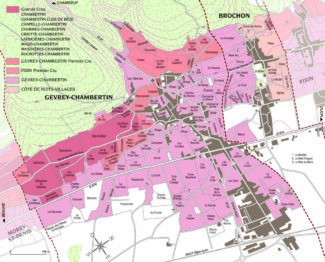
The 2014 Vintage: Ten Years Of Age Matures Into A Classic
If you follow this sort of thing, you know that in Burgundy, Vintage 2015 was a media-magnet, extraordinary throughout the Côte d’Or. A mild, wet winter replenished water reserves sorely needed during a hot, dry summer. A few inches of rain in June, followed by a further inch or so in August—critical to refresh the vineyards and ensure even ripening, but not so much as to mask the region’s diverse terroir in sweet fruit.
All this 5/5 scoring talk is fine, but it should not serve as temptation for any true Burgundy lover to overlook 2014.
A more difficult vintage by all accounts, the summer of 2014 was wet and chilly interspersed with a few hot days in July and worsening weather during the first half of August. There was surprisingly little mildew, but maturation proceeded slowly. And then, things took a turn for the better: The skies cleared, the mercury rose, and victory was seized from the jaws of disease, decimated yields and vinegar flies.
Especially in the Côte de Nuits, the final verdict is just becoming obvious. The wines, though less voluptuous and rich than 2009 or 2012, but also riper than 2008 (which had a similar growing season) have proven to be classic. Ten years later, the proof is in the goblet; these wines, pure and limpid at bottling, have matured admirably and are of a weight and concentration that indicates near peak performance.
Domaine Dominique Gallois
Prior to taking over the family estate in 1989, Dominique Gallois studied catering in Paris and ran his own restaurant for six years. When he returned to Burgundy, the domain consisted of six acres in Gevrey-Chambertin which his father had managed for forty years, selling the grapes to négociants. Dominique began to renovate the property and in 1989 (after purchasing additional acreage in Combe aux Moines, Petits Cazetiers and Goulots) to bottle his own product, looking first to private customers to build a reputation.
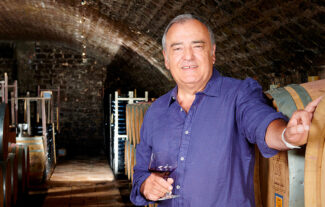
Dominique Gallois, Domaine Dominique Gallois
Recognizing that he works in terroir that is the envy of the world, Dominique takes special care to work the domain by hand, without pesticides or herbicides. Says Gallois, “Our year is quite full; winter months are dedicated to vine maintenance and Guyot-style pruning. During spring and summer, several tasks are performed allowing yields to be controlled and managing the healthiness of the future grapes. Harvesting is manual—we count on a small, faithful team to carry out the first sorting on the vine. Thereafter, grapes pass over a sorting table where bunches are inspected so as to conserve only the best fruit.”
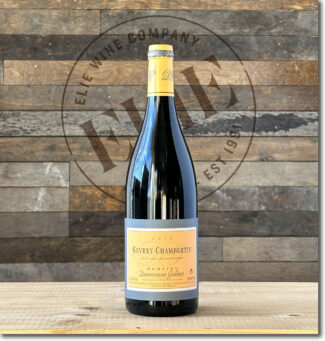 Bottle 1 • Village Pack
Bottle 1 • Village Pack
Domaine Dominique Gallois, 2014 Gevrey-Chambertin ($95)
In Burgundy, any serious discussion of terroir begins at the Village level, and the most important of these appellations are aligned in a neat north-to-south line from Marsannay to Maranges. They generally located on a commune’s eastern side, where the angle of slope is slight, or along the far western fringe, adjacent to forest-capped ridgelines, where both elevation and slope are far more significant. Not all are created equal, of course, and it can be expected that the concentration of Gallois’ Gevrey, blended from numerous climats and celebrating its tenth anniversary, is at its finest. The nose shows deep cherry spice, licorice, and earth, with perfectly integrated oak and fruit leather, the palate cinnamon and black pepper and a finish that remains both rugged and refined.
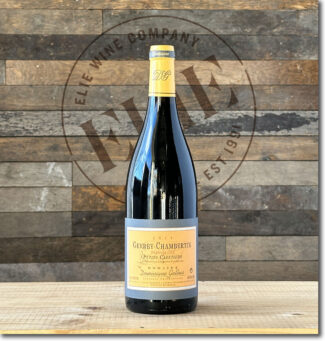 Bottle 1 • Premier Cru Pack
Bottle 1 • Premier Cru Pack
Domaine Dominique Gallois, 2014 Gevrey-Chambertin Premier Cru Petits Cazetiers ($120)
Les Petits Cazetiers is a tiny Premier Cru climat just west of the village of Gevrey-Chambertin; the enclave is walled and planted entirely to Pinot Noir, covering barely two acres. In fact, Gallois is the only producer making a wine under the Les Petits Cazetiers Premier Cru name. From the well-drained limestone and marl comes a wine rich in earth tones, most notably mushroom, which has evolved into tertiary notes of nuts, spice and dried cherry.
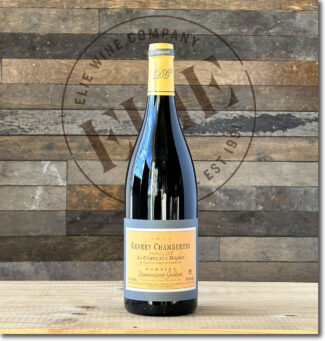 Domaine Dominique Gallois, 2014 Gevrey-Chambertin Premier Cru La Combe aux Moines ($150)
Domaine Dominique Gallois, 2014 Gevrey-Chambertin Premier Cru La Combe aux Moines ($150)
At 1300 feet, Combe aux Moines is among most elevated in Burgundy, and the wines are both rarefied and rustic, exhibiting bright red fruit alongside earthy characters. The 12-acre climat sits at Gevrey’s northern end, quite a distance from the contiguous Grand Cru hill. Instead, Combe aux Moines is bounded by other east-facing Premier Cru climats like Les Cazetiers and Champeaux. It angles slightly north, meaning that the vines have less exposure to the sunshine than the south-facing vineyards that lie just outside the village; however, the steep slope ensures that the morning sunlight is distributed efficiently. Soils are free draining and fairly infertile, lessening the vigor of the vines and leading to the production of small, concentrated grapes often been linked to the muscularity of the finished wines. This one retains a solid core of red fruit behind the savory scents of tobacco and forest floor.
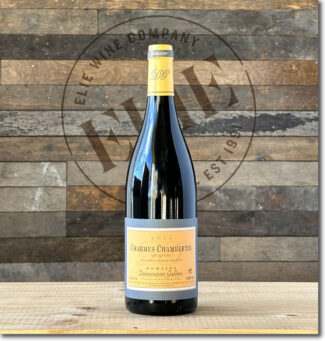 Domaine Domonique Gallois, 2014 Charmes-Chambertin Grand Cru ($390)
Domaine Domonique Gallois, 2014 Charmes-Chambertin Grand Cru ($390)
One of the lesser known Grand Cru sites in Gevrey, Charmes occupies the lowest and most shallow slopes of the Grand Cru belt close to the border with Morey-Saint-Denis. It consists of a number of blocks divided by minor roads or walls and in general, produces softer, less muscular wines than many of its neighboring Grand Crus, including Chambertin itself. As such, the longevity is not as pronounced, and in consequence, tends to mature more quickly. It remains a varsity-level Burgundy, however, with a deeply structured core, showing the cherry, bilberry of its youth along with the mineral and spice of adulthood, then happily builds to a stone and spice finish that displays equilibrium and finesse.
Domaine des Tilleuls
Damien Livéra, whose Italian great-grandfather founded the domain in 1920, decided on a different approach when he took the reins in 2007. Formerly a wine made from négociant-purchased fruit (mostly Bouchard Père and Louis Jadot) Damien decided to go maverick. First he improved the Tilleuls’ ‘cuverie’—wine storehouse—and expanded the amount of wine drawn from the domain’s 21 acres that was bottled in house. This vineyard land includes plots of Bourgogne, Hautes-Côtes de Nuits, Fixin, and Gevrey-Chambertin, the Crus En Champs, Évocelles and Clos Village as well as a plot of Chapelle-Chambertin in the sub-climat Gémaux.
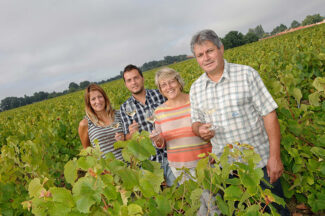
Damien Livéra and Family, Domaine des Tilleuls
Damien also made a push to see the family’s vines cared for with a more earth-friendly and quality-focused attitude, pushing for lower yields and healthier, more balanced fruit. Vineyards are cared for sustainably, which includes plowing the soils (no herbicides) and using indigenous yeasts in the cellar. A majority of the estate’s older Pinot Noir vines were planted in the 1950s and 1960s. Grapes are harvested by hand and mostly destemmed, fermented in tank and then aged in French oak barrels in very cold cellars—so cold that malolactic fermentations may extend over a full year. The family uses from 25% new oak on base wines to 40 percent on Villages-level wines and between 50 to 100% for Grand Crus. Selections are bottled unfined and unfiltered.
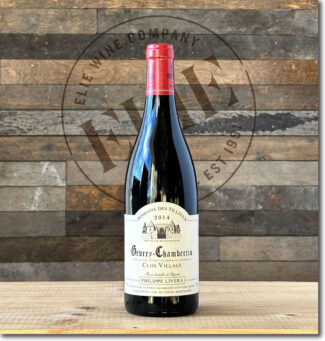 Bottle 2 • Village Pack
Bottle 2 • Village Pack
Domaine des Tilleuls, 2014 Gevrey-Chambertin ‘Clos Village’ ($94)
This is the Livéra family’s flagship wine; they own four acres of the Gevrey-Chambertin wall-enclosed Clos Village and make the wine with the intention that it be cellared: Vinified in 40% new oak for 12 months and then 6 months in stainless-steel vats, with neither fining nor filtration. Damien Livéra recommends waiting a minimum of 5 years before opening; ten if circumstances allow. A complex and structured wine in the full bloom of earthy elegance.
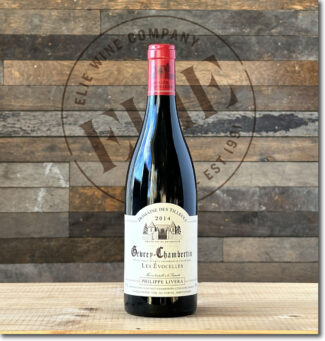 Domaine des Tilleuls, 2014 Gevrey-Chambertin ‘Les Évocelles’ ($94)
Domaine des Tilleuls, 2014 Gevrey-Chambertin ‘Les Évocelles’ ($94)
Évocelles is a 25-acre upper-hillside vineyard, sharply inclined and full of stones. It is located at the very north-east portion of Gevrey, principally in Brochon, bordering the Premier Cru of Champeaux and Les Goulots. The primary geology of this Village-level lieu-dit is clay-limestone and the vines were planted in 1950. The palate remains medium-bodied with still-supple tannins and a fine bead of acidity—quite an elegant Les Évocelles with a lightly spiced finish.
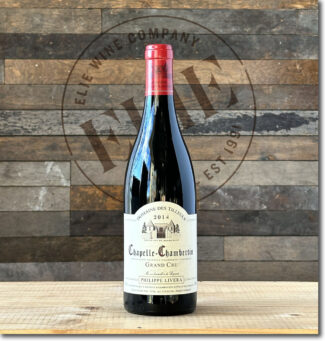 Domaine des Tilleuls, 2014 Chapelle-Chambertin Grand Cru ($350)
Domaine des Tilleuls, 2014 Chapelle-Chambertin Grand Cru ($350)
One of the area’s lesser-known sites in the Grand Cru belt, Chapelle is located immediately below the commune’s more prestigious climat, Chambertin Clos-de-Bèze. It covers 13.5 acres of limestone-rich soil whose stony texture allows for free drainage and forces the vines to grow deep, strong root systems in search of water. In ideal seasons, warm days and cool nights help the grapes maintain a balance between natural sugars and acidity, which echo in the finished wines. In the 2014 vintage, the terroir has emerged from behind overt vintage character and is now clearly on display, having mellowed into appealing and exotic aromatics.
Thibault Liger-Belair
Winemaking has been the legacy of Liger-Belair family for a quarter of a millennium. Prior to establishing his own domain, Domaine Thibault Liger-Belair studied oenology, worked for a communications firm in Paris and started an internet company to discover and sell high quality wines. Still, the vines beckoned, and in 2001, at the age of 26, he returned to them. The following year saw his first harvest of Nuits-Saint-Georges, and in 2003, he expanded into Richebourg Grand Cru, Clos Vougeot Grand Cru and Vosne-Romanée Premier Cru Petits Monts and in 2004, he discovered biodynamics, a train on which he has been a front-row passenger ever since.
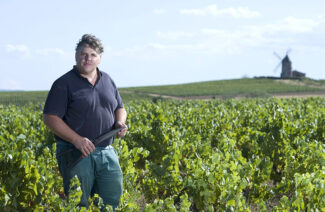
Thibault Liger-Belair
“I saw a change in my vineyard, which went from grey soils to brown/red and then sometimes to black.” Still, his overarching philosophy is that each vineyard needs something different: “I don’t like 100% of anything: new barrels, whole clusters. My job is to decide which grapes we have and then decide a viticulture and winemaking approach.”
In 2018, he made wine from 23 different appellations and purchased grapes from a ten more, but did the work there. “We don’t purchase grapes where we don’t do the work,” he says.
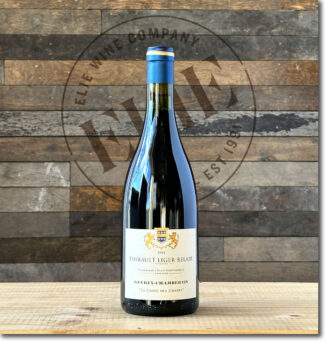 Bottle 3 • Village Pack
Bottle 3 • Village Pack
Thibault Liger-Belair, 2014 Gevrey-Chambertin ‘La Croix des Champs’ ($99)
Liger-Belair’s scant 1-acre parcel of 40-year-old vines is grown in the fairly rich soils of La Croix des Champs lieu-dit on the far side of the Route Nationale. The wine remains expansive with a solid and, complex mineral layer, well integrated oak and fine-grained tannins behind notes of tarragon, cedar and chocolate.
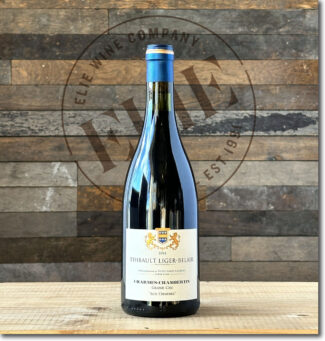 Thibault Liger-Belair, 2014 Charmes-Chambertin ‘Aux Charmes’ Grand Cru ($370)
Thibault Liger-Belair, 2014 Charmes-Chambertin ‘Aux Charmes’ Grand Cru ($370)
‘Aux Charmes’ borders the Grand Cru Chambertin; it is east-facing with iron-rich soils and vines between 80 and 100 years old. Thibault Liger-Belair’s parcel was planted in 1946, three-quarters of an acre located at the top of the vineyard, just below the border between Chambertin and Latricières. The ‘greenness’ of the scent remains intact as an integral part of this wine’s beauty, with touches of herbal tea and underbrush.
Domaine Heresztyn-Mazzini
Florence and Simon Heresztyn-Mazzini hail from different winemaking regions—Florence from Burgundy and Simon from Champagne. After ten years of working Heresztyn-owned vineyards in Gevrey-Chambertin, the couple decided to start their own venture on 14 acres spread across the villages of Gevrey-Chambertin, Morey-Saint-Denis, and Chambolle-Musigny. 2012 was their first vintage.
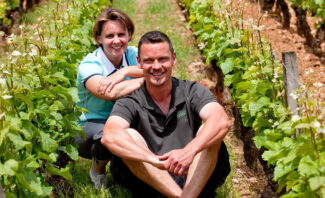
Florence and Simon Heresztyn-Mazzini, Domaine Heresztyn-Mazzini
“Here in Gevrey-Chambertin,” Simon says, “we have had only this one objective since 2012: to work according to organic and biodynamic practices in the vineyard, vat-house, and cellar and to offer Grand Cru, Premier Crus and Village wines that are closest to the identity of their climats. Our vineyards were certified organic in 2014 and we have been farming biodynamically in 2015.”
Florence adds, “We are closely attached to the Côte de Nuits and its unique terroirs and work relentless to bring out the region’s best qualities. Simon and I make it a point of personal pride to respect the region’s soils and natural environment.”
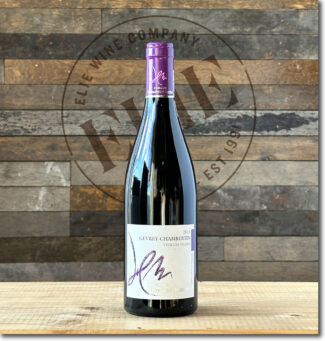 Bottle 4 • Village Pack
Bottle 4 • Village Pack
Domaine Heresztyn Mazzini ‘Vieilles Vignes’, 2014 Gevrey-Chambertin ($91)
Pinot Noir made from 50 year-old vines and aged in Allier and Tronçais barrels for 18 months; it holds onto a great portion of its dark fruits and tannic spine. An exceptionally well-made Village wine that has received better reviews than several Premier Cru Gevreys from the 2014 vintage.
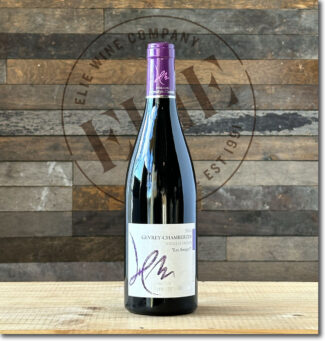 2014 Domaine Heresztyn Mazzini ‘Vieilles Vignes’ Gevrey-Chambertin ‘Les Songes’ ($91)
2014 Domaine Heresztyn Mazzini ‘Vieilles Vignes’ Gevrey-Chambertin ‘Les Songes’ ($91)
Les Songes is smaller than an acre of clay/limestone peppered with marl-rich fossilized shells. The wine was 35% whole-bunch fermented on wild yeast fermentation and aged in 30% new wood oak barrels for 16-18 months. The wine retains plenty of energy and a plumpish body; the tannins are mellow and silky while the acidity has reined in to show cool minerality and edge.
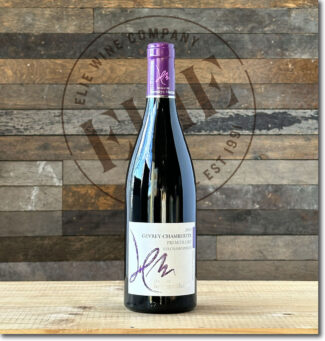 Bottle 2 • Premier Cru Pack
Bottle 2 • Premier Cru Pack
Domaine Heresztyn-Mazzini, 2014 Gevrey-Chambertin Premier Cru Champonnets ($120)
Champonnets is a Premier Cru climat just south of Gevrey-Chambertin on the northern edge of the Grand Cru hillside. Wines from this 8-acre vineyard tend to be less robust than others from the area, displaying silkier tannins, due in part to the northeasterly aspect where the cold winds that flow through the Combe de Lavaux gives Champonnets a cooler mesoclimate than the more sheltered Grand Cru sites that face southeast on the other side of the hill. While vines still have sufficient sunlight during the growing season to develop good sugars and acidity, the grapes lack the concentration of warmer, sunnier climats. Still, the high proportions of limestone is well-suited to the Pinot Noir that grows here, storing sufficient water for hydration while also providing plentiful drainage. The wine shows dried fruit and warm leather on the bouquet along with a slightly smoky palate and a chamois texture from the tannins.
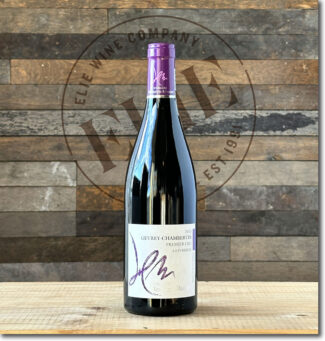 Domaine Heresztyn-Mazzini, 2014 Gevrey-Chambertin Premier Cru La Perrière ($120)
Domaine Heresztyn-Mazzini, 2014 Gevrey-Chambertin Premier Cru La Perrière ($120)
La Perrière runs adjacent to the Mazis-Chambertin Grand Cru, separated only by a dirt path. The vineyard’s name refers to its former occupation as a quarry, and as might be expected, there is a pronounced minerality to wines that bear this designation. Soil from the surrounding area was used to fill in the quarry and this light, loamy topsoil is underscored by free-draining calcareous stones. This elegant and solid-state wine could easy withstand another half-decade in the cellar, but for now it shows perfume of wood, and sous bois with a mineral-inflected finish shaped by impressively fine-grained tannins.
Domaine Odoul-Coquard
Sébastien Odoul—whose name should never be associated with that non-alcohol beer from Anheuser Busch (!) cut his winemaking teeth at Domaine Dujac, Mommessin, and Domaine Denis Mortet. In 2004, he returned to the family domain to join his parents, Sylvette and Thierry, and as of 2009, he took over the estate as vigneron.
In all, the family farms 25 acres in 21 different appellations throughout the Côte de Nuits; most notably, they own the majority of the lieu-dit vineyard of Les Crais Gillon in Morey-Saint-Denis. All of their farming is done with ‘lutte raisonnée’, a sustainable viticulture practice.
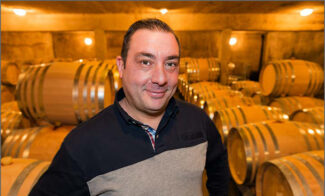
Sébastien Odoul, Domaine Odoul-Coquard
Discussing his different properties, Odoul says, “Morey-Saint-Denis is about fruit and finesse. Not as much finesse as Chambolle-Musigny though. The tannins are more supple than in Gevrey-Chambertin. Basically one could say that Morey-Saint-Denis is like a blend of Chambolle and Gevrey. When it comes to the fruit it is more Chambolle in character, while the tannins are more well-integrated, as in Gevrey.”
After bottling, Odoul gives a third of the result to the commune, explaining, “We have had this arrangement since 1988. My father was the grower in the village with the least amount of Premier Cru vineyard, so they let him have the Clos la Riotte. Since we are not the owners we can’t say it’s a monopole. The commune sells its part with a different label.”
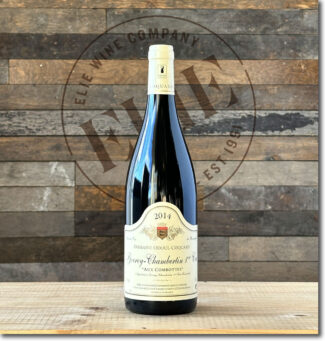 Bottle 3 • Premier Cru Pack
Bottle 3 • Premier Cru Pack
Domaine Odoul-Coquard, 2014 Gevrey-Chambertin Premier Cru Aux Combottes ($140)
12-acre Aux Combottes is Gevrey-Chambertin’s southernmost Premier Cru climat, sitting on the border with Morey-Saint-Denis. The terroir is not quite as high-quality as the Grand Cru vineyards which surround it, but it is certainly one of Gevrey-Chambertin’s top Premier Cru sites. In fact, in the hands of top producers, Combottes can outperform other Premier Crus and some lesser Grand Crus—it’s primary (and perhaps only) drawback is that it lies in a slight depression that funnels cold westerly winds over the vines during the growing season, making complete ripening a challenge. This wine is drawn from three vine ages; according to Sébastien, they are “10, 25 and ‘very old.’” Having seen 75% new oak, wood spice remains to shore up the middle palate of dried strawberry and cedar, but has by now taken a back seat.
Domaine Bernard Dugat-Py
Dugat-Py flies a bit under the radar in Gevrey, possibly overshadow by or confused with Domaine Claude Dugat. Same family, different property.
Located at the base of the Combe de Lavau, Dugat-Py has been producing world-class wines since its founding. The aging cellar forms the focal point of the domain’s architecture; L’Aumôneri, is essentially a small abbey that was built by the Diocese of Dijon in the 11th century, making it the oldest cellar in Burgundy today.
Bernard Dugat purchased the Gevrey vines that produced his first wines in 1975; Py is the maiden name of Bernard’s wife, Jocelyne. In 1996, their son Loïc joined the family business and is now at the helm. He was instrumental in starting their conversion to organic viticulture, for which they gained full accreditation in 2003.
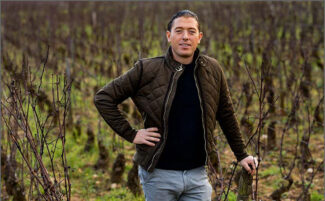
Loïc Dugat-Py, Domaine Dugat-Py
Loïc is passionate about old vines, always searching for old parcels of Pinot Fin or Chardonnay. This dedication has resulted in the domain now owning vines that range from 65 to more than 100 years old in Côte de Nuits and Côte de Beaune. Consequently, nearly every wine in the line-up is designated either as Vieilles Vignes or Très Vieilles Vignes. They tend to these mature vineyards with meticulous care, using homemade biodynamic teas throughout (they are certified biodynamic). The Premier Cru and Grand Cru sites are horse-plowed. The vines are never trimmed, allowing the canopies to reach a height of seven or eight feet in the summer months.
Loïc says, “Today our climats include 23 acres of Pinot Noir and 3 acres of Chardonnay, including the original vineyards located in Gevrey. We have always produced classic Vins de Garde, deep in color, with explosive fruit and chiseled tannins. I refuse to chaptalize, acidify, inoculate or add anything to juice; sulfur is only added prior to bottling. And while the wines are still deep and powerful, I like to think they have more balance and finesse than ever. Also never elevated, the alcohol rarely surpasses 13.5%, and harvest now occurs on the earlier side to retain freshness and elegance.”
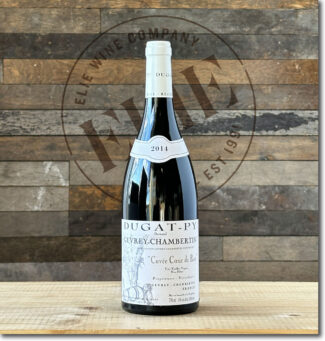 Domaine Dugat-Py ‘Cuvée Cœur de Roy, Très Vieilles Vignes’, 2014 Gevrey-Chambertin ($170)
Domaine Dugat-Py ‘Cuvée Cœur de Roy, Très Vieilles Vignes’, 2014 Gevrey-Chambertin ($170)
From tiny-yield vines ranging in age from 50 to 105 years old; the crop level here is just 23 hectoliters per hectare. The wine is a step up in intensity and sweetness from the Évocelles, with size to support its substantial ripe tannins for the past decade. Its once substantial fruit now shows a nice finishing dryness laced with bitter chocolate, sweet leather and pie spice.
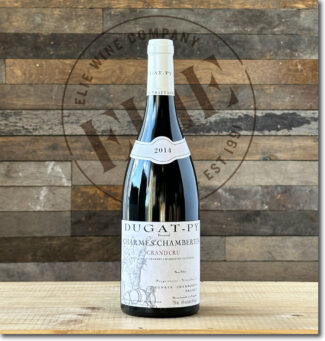 Domaine Dugat-Py, 2014 Charmes-Chambertin Grand Cru ($890)
Domaine Dugat-Py, 2014 Charmes-Chambertin Grand Cru ($890)
A truly brilliant Gevrey; Dugat-Py’s 2014 Charmes-Chambertin was built using around 40% whole bunch fruit, and remains blessed with a rich bouquet with layers of macerated fruit mixed with a retaining-wall of new oak. The palate is dry on the entry and shows granular tannin as a touch of orange rind with a spice note towards the structured finish that is Mazoyères-like in style.
Domaine Bart
Fifteen years ago, the winegrowers of Marsannay started the process of having part of the appellation upgraded to Premier Cru. At Domaine Bart, which produces as many as nine different Marsannay bottlings in a given vintage, it is believed that 25% and 30% of the appellation is up for this bump upstairs. Pierre Bart, the sixth generation to run Domaine Bart, says, “We are trying to show which climats would be of interest and which ones should remain in the village appellation. My guess is that there will be five or six Premier Crus. probably the largest ones like Champs Perdrix, Champ Salomon, Clos du Roi, Longeroies and Montagne.”
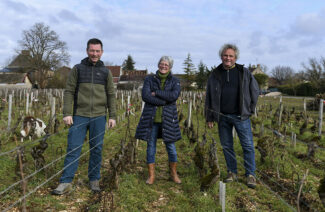
Pierre Bart and Family, Domaine Bart
The Bart domain covers 54 acres, mostly in Marsannay, but with a few parcels in Fixin, Gevrey-Chambertin, Chambolle-Musigny and Santenay. “My grandmother comes from the same family as Domaine Bruno Clair,” explains Pierre Bart. “Part of the vines come from that side of the family, part from my grandfather’s side. The Bonnes Mares and the Chambertin Clos de Bèze mainly come from my grandmother. 35 years ago, when my uncle arrived at the domain, the style of the wines changed. He increased the size of the holding, mainly in Marsannay. He chose to improve quality, both in terms of equipment and in winemaking. Since then we haven’t changed our vision a single iota.”
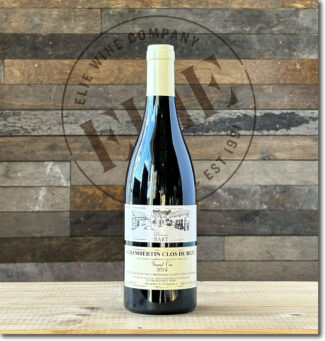 Domaine Bart, 2014 Chambertin Clos de Bèze Grand Cru ($550)
Domaine Bart, 2014 Chambertin Clos de Bèze Grand Cru ($550)
Clos-de-Bèze may be almost as highly regarded as its southern neighbor Chambertin, whose soils are similar, made up of pebbly, free-draining limestone with a good proportion of clay. Like Chambertin, Bèze makes a wine that is classically Gevrey-Chambertin—perfumed, full-bodied, concentrated and structured, and worthy of being aged for many years. Appellation law allows producers to label wines from Clos-de-Bèze as Le Chambertin (but not the other way around), and while the latter is often considered the apogee of Gevrey-Chambertin, Clos-de-Bèze is the older of the pair. Records show the vineyard, owned and run by the Abbey of Bèze, was already known in the 7th Century, well before it was ceded to the Chapter of Langres, which by that stage had acquired Mr. Bertin’s field, ‘le champ de Bertin’ in the 12th Century.
Believing that his Clos de Bèze tends to taste almost too ready to drink at bottling, Pierre Bart ends fermentation by raising the temperature and giving the wine a couple of powerful punch-downs to fix a bit more tannin. The 2014 may still be in its late youth, showing concentrated, almost brûlée-like blackcurrant, cherry compote and an overflowing spice-box behind a velvety expression where licorice and chocolate come into play alongside musk, truffle and forest floor.
- - -
Posted on 2024.01.06 in France, Champagne, Wine-Aid Packages
Featured Wines
- Notebook: A’Boudt Town
- Saturday Sips Wines
- Saturday Sips Review Club
- The Champagne Society
- Wine-Aid Packages
Wine Regions
Grape Varieties
Albarino, Albarín Blanco, Albarín Tinto, Albillo, Aleatico, Aligote, Arbanne, Aubun, Barbarossa, barbera, Biancu Gentile, bourboulenc, Cabernet Franc, Caino, Caladoc, Calvi, Carcajolu-Neru, Carignan, Chablis, Chardonnay, Chasselas, Cinsault, Clairette, Corvina, Counoise, Dolcetto, Erbamat, Ferrol, Frappato, Friulano, Fromenteau, Gamay, Garnacha, Garnacha Tintorera, Gewurztraminer, Graciano, Grenache, Grenache Blanc, Groppello, Juan Garcia, Lambrusco, Loureira, Macabeo, Macabou, Malbec, Malvasia, Malvasia Nera, Marcelan, Marsanne, Marselan, Marzemino, Mondeuse, Montanaccia, Montònega, Morescola, Morescono, Moscatell, Muscat, Natural, Niellucciu, Parellada, Patrimonio, Pedro Ximénez, Petit Meslier, Petit Verdot, Pineau d'Aunis, Pinot Blanc, Pinot Gris, Pinot Meunier, Pinot Noir, Pouilly Fuisse, Pouilly Loche, Poulsard, Prieto Picudo, Riesling, Rondinella, Rose, Rousanne, Roussanne, Sagrantino, Sauvignon Blanc, Savignin, Sciacarellu, Semillon, Souson, Sparkling, Sumoll, Sylvaner, Syrah, Tannat, Tempranillo, Trebbiano, Trebbiano Valtenesi, Treixadura, Trousseau, Ugni Blanc, vaccarèse, Verdicchio, Vermentino, Xarel-loWines & Events by Date
- July 2024
- June 2024
- May 2024
- April 2024
- March 2024
- February 2024
- January 2024
- December 2023
- November 2023
- October 2023
- September 2023
- August 2023
- July 2023
- June 2023
- May 2023
- April 2023
- March 2023
- February 2023
- January 2023
- December 2022
- November 2022
- October 2022
- September 2022
- August 2022
- July 2022
- June 2022
- May 2022
- April 2022
- March 2022
- February 2022
- January 2022
- December 2021
- November 2021
- October 2021
- September 2021
- August 2021
- July 2021
- June 2021
- May 2021
- April 2021
- March 2021
- February 2021
- January 2021
- December 2020
- November 2020
- October 2020
- September 2020
- August 2020
- July 2020
- June 2020
- May 2020
- April 2020
- March 2020
- February 2020
- January 2020
- December 2019
- November 2019
- October 2019
- September 2019
- August 2019
- July 2019
- June 2019
- May 2019
- April 2019
- March 2019
- February 2019
- January 2019
- December 2018
- November 2018
- October 2018
- September 2018
- August 2018
- July 2018
- June 2018
- May 2018
- April 2018
- March 2018
- February 2018
- January 2018
- December 2017
- November 2017
- October 2017
- September 2017
- August 2017
- July 2017
- June 2017
- May 2017
- April 2017
- March 2017
- February 2017
- January 2017
- December 2016
- November 2016
- October 2016
- September 2016
- August 2016
- July 2016
- June 2016
- May 2016
- April 2016
- March 2016
- February 2016
- January 2016
- December 2015
- November 2015
- October 2015
- September 2015
- August 2015
- July 2015
- June 2015
- May 2015
- April 2015
- March 2015
- February 2015
- January 2015
- December 2014
- November 2014
- October 2014
- September 2014
- August 2014
- July 2014
- June 2014
- April 2014
- March 2014
- February 2014
- January 2014
- December 2013
- November 2013
- October 2013
- September 2013
- August 2013
- July 2013
- June 2013
- May 2013
- April 2013
- March 2013
- February 2013
- January 2013
- December 2012
- November 2012
- October 2012
Search



